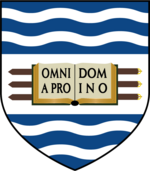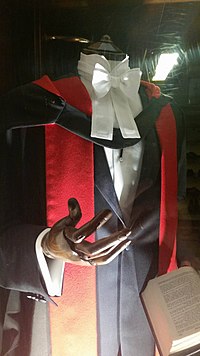University of Lendert: Difference between revisions
(→Study) |
|||
| Line 106: | Line 106: | ||
==Study== | ==Study== | ||
The curriculum for the Bachelor and Master of Arts at the University of Aldesey is: | [[File:Ph.D._gown,_Cambridge_University.jpg|thumb|200px|left|The academic gown of a Doctor of Letters.]]The curriculum for the Bachelor and Master of Arts at the University of Aldesey is: | ||
'''Bachelor of Arts:''' | '''Bachelor of Arts:''' | ||
Revision as of 07:14, 19 April 2019
 Coat of Arms of the University of Aldesey | |
| Latin: Universitas Aldesiensis | |
Other name | The Chancellour, Masters and Scholars of the University at Aldesey |
|---|---|
| Motto | Omnia pro Domino |
Motto in English | All be unto the Lord |
| Type | Corporation by prescription |
| Established | c. 8th century as a monastic school c. 1256 as a university |
Religious affiliation | Church of Nortend |
| Endowment | ~ £101,200,000 |
| Chancellor | The Rt Rev'd Dr William Laseby, Bishop of Chepingstow |
| Rector | The Rt W'shipful Dr Thomas Matthew |
| Students | ~ 3,400 |
| Location | Aldesey , Narland , |
| Language | English, Latin |
| Colors | Light blue and white |
| Sports | Boating, hunting |
The University of Aldesey, formally The Chancellour, Masters and Scholars of the University at Aldesey, is one of the three universities in Great Nortend located in the town of Aldesey, in Narland. It is the oldest university and the second largest after the University of Limmes in Great Nortend. It grew as a monastic school attached to Aldesey Abbey from the 8th century, and developed into a collegiate university during the 12th and 13th centuries.
It is built upon two large natural islands in the River Lither, Upper and Lower Eyote, which have over the centuries has been nearly fully covered by the buildings of the university, with the town of Aldesey developing on the banks of the river.
Governance
The University as a body is distinct from its sixteen constituent colleges. Each of the sixteen colleges are independent and responsible for the lodging, education and nourishment of its students. Students are admitted to a college through the process of Matriculation, when they formally become members of the University. Henceforth, they are bound by the University's statutes and regulations. For example, students, when in public, are required to at all times wear the gowns of their status. The University's statutes, regulations and ordinances are enforced by the University's Proctors, police, and student beadles, who have the power to fine and confine, and in extreme cases, to rusticate or ban (expel).
The formal council body of the University is known as the Great Congregation, comprised of all masters of the University, who are those students with a Master of Arts or were otherwise a Doctor of Letters, Science, Music, Laws, Physic or Divinity. It is considered the sovereign body of the University. It has a role in determining University's statutes and regulations, subject to the assent of the Chancellour, as well as academic matters such as examinations, rustication, matriculation, the curriculum and lectures, as well as granting graces, dispensations and degrees.
The Congregation, with its large size, meets normally every three years, and delegates its powers to the smaller Minor Congregation, or Convocation of Regent Masters, who have power over academic matters, however cannot pass statutes. Statutes are deliberated upon by the Convocation, and if agreed to, referred back to the entire Congregation, which can accept it or reject it at the triennial meetings or by postal ballots.
Faculties
As with the other two Erbonian universities, the University of Aldesey retains the four faculties of the mediaeval university tradition, being the Faculties of Arts, Physic, Laws and Divinity. Since the reforms of the 18th century, each faculty is more relevant to their respective professions—the sciences and humanities, the practice of medicine and law, and of holy orders—than the more wholly academic approach favoured thitherto.
All students enter the university in the Faculty of Arts, excepting monks and friars who are admitted straight into the Faculty of Divinity. The undergraduate curriculum of the Faculty of Arts is split into two, with the first half for the Bachelor of Arts and the latter the Master of Arts. The curriculum for the Bachelor of Arts focusses on the trivium of liberal arts, being rhetoric, logic and grammar, in addition to history, ethics and politics. The degree lasts two years, and is attained by most students. The second half of the course, for the Master of Arts, involves study in the quadrivium, of music, astronomy, arithmetic and geometry, along with further studies in algebra, calculus, physics, metaphysics and theology. The entire course takes around another two years, for a total of three years. Before graduating, however, the student is required to obtain the licentia docendi, or licence to teach, from the local bishop. This is granted as a matter of course.
Academics
Teaching in all four universities is undertaken by the regent masters, doctors and professours of the University.
A master is any scholar of a University who has been granted the licentia docendi, or licence to teach which is required before obtaining the Master of Arts. After graduating with the Master of Arts, a person is permitted to lecture at the University. There is traditionally a period of regency where a master becomes a regent master.
Such a regent master usually is simultaneously reading for a further degree. His duties are not particularly onerous and the position is well-paid at most colleges, and include delivering lectures to undergraduate students, attending Convocation, looking after undergraduate students, and otherwise assisting with the peace and good order of the University.
A doctor is a master who possesses a doctorate in a faculty. They have the responsibility of teaching masters (and in the Faculty of Divinity, monastic undergraduates) reading for a bachelor's or doctor's degree.
All regent masters and doctors of the University are also attached to a college and are known as fellows. They form the governing body of a college, under their warden, master &c.
A professour is a fellow who has been given a chair in a specific field by a college or the University or, in the case of Professours Regius, by the Crown. They are required to deliver a certain number of lectures to normally master students of the University studying for their bachelor or doctorate every year.
Study
The curriculum for the Bachelor and Master of Arts at the University of Aldesey is:
Bachelor of Arts: 1st year: Logic, Rhetoric, Oration, Poetry, Ancient History and Grammar (Responsions) 2nd Year: Ethics, Modern History, Economics, Politics, Diplomacy, and Theology (Determination)
Master of Arts: 3rd Year: Metaphysics, Biology, Physics, Astronomy, Geometry, Mathematics and Music (Quodlibetica)
Study in the higher faculties follows a similar path, with a two or three-year bachelor's degree and then a doctoral degree by thesis which involves propounding, impugning and propugning. Most students do not obtain a doctorate, with the higher bachelor's degree sufficing in most of the learned professions. Doctors of the civil courts of course must receive the Doctorate of Laws. Medical doctors usually only possess a bachelor's degree in physic, but are still commonly addressed as 'Dr'.
Further study in the Faculty of Arts is also possible, with there being a split between the 'letters course', the music course, and the 'science course'. The former course focusses on the humanities, which is mostly based on the course of the Bachelor of Arts, with an especial focus on the classics, history, poetry and rhetoric, the music course on music theory and practice, and the latter is based on the Master of Arts, being focussed on the more scientific aspects of study with specialisation available in each. These courses all include the bachelor degree as well as a doctorate.
For the Bachelor and Master of Arts, teaching is in the form of lectures taken by regent masters, supplemented in the philosophical subjects with frequent disputations (debates), and in all subjects, weekly declamations (essays) with bachelor or fellow tutors. Ordinary lectures for undergraduates and bachelors are taken by regent masters and involve exposition and instruction of the compulsory subject matter. Cursory lectures are taken by senior bachelors and regent masters and are elective subjects.
Students
Students at the University of Aldesey are either undergraduates or masters, the former being those without a degree and the latter those with a masters degree. Undergraduates are graded into five ranks: noblemen; gentlemen; commoners; battelers; and servitors. Most colleges have abolished servitors, however some still retain the rank. Different ranks of undergraduates are entitled to different academic gowns and hats which mark their status.
International students
The University accepts international students from all around the world. Not all colleges, however, accept international students. There are approximately 230 international undergraduate students at the University, as of 2018.
Examinations
Before admission to any degree, a student is required to partake in several examinations, not all of which are academically relevant. For progression to the Master of Arts, the following examinations are required.
The first examination is the Matriculation examinations, which is an exam taken before matriculation to prove scholastic competence. It serves as the culmination of the sixth forms of senior school and is generally an examination of competence in Latin in written form as well as general capability in the English and Greek tongues.
The second examination is taken at the end of the first year, and is known as the Responsions. An undergraduate must satisfy three regent masters of his choice, de questione respondens in a public viva voce question-and-answer format in Latin. This has generally become a formality, and the questions asked often come from books of Responsion questions and their prescribed answers.
The final examination for the Bachelor of Arts degree is the Determination. The Determination has two parts, one being a public debate or disputation on a matter in Latin, and the latter being a written examination in English. The public debate is between two undergraduate students and is generally a formality.
The first examination for the Master of Arts is taken at the end of the year, and is known as the Licentiate examinations. It is a written examination of knowledge and serves as the main examination in English for the Master of Arts. A bachelor recieves his licentia docendi this way.
The final examination for the Master of Arts is another public debate or disputation in Latin, known as the Quodlibetica, whereof the topic is chosen by the candidate. This is a formality as well, as the actual examinations are conducted in the Licentiate examinations. Humorous questions are often asked by the masters, which often require set answers.
This page is written in Erbonian English, which has its own spelling conventions (colour, travelled, centre, realise, instal, sobre, shew, artefact), and some terms that are used in it may be different or absent from other varieties of English. |


